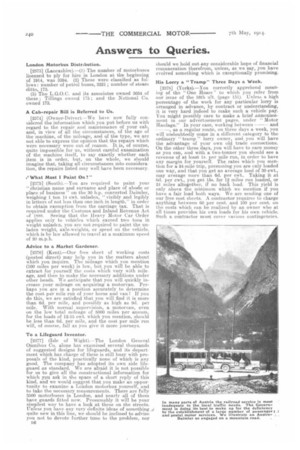Answers to Queries.
Page 20

If you've noticed an error in this article please click here to report it so we can fix it.
London Motorbus Distribution.
[2373] (Lancashire),—(l) The number of motorbuses licensed to ply for hire in London at the beginning of 1914, was 3394. (2) These were classified as follows : number of petrol buses, 3221; number of steam ditto, 17a (3) The L.G.O.C. and its associates owned 3034 of these ; Tillings owned 17ã; and the National Co. owned 173.
A Cab-repair Bill is Referred to Us.
[2374] (Owner-Driver).—We have now fully considered the information which you put before us with regard to the repair and maintenance of your cab, and, in view of all the circumstances, of the age of the machine, of the mileage, and ef the type, we arc Hot able to express the opinion that the repairs which were necessary were out of reason. It is, of course, quite impossible for us, without careful examination of the machine itself, to say exactly whether each item is in order, but, on the whole, we should imagine that, taking all circumstances into eonsidera• tion, the repairs listed may well have been necessary.
.` What Must I Paint On?"
[2375] (South).—You are required to paint your "cbristian name and surname and place of abode or place of business" on the 30 h.p. converted Daimler, weighing 1 ton 14 cwt. unladen, "visibly and legibly in letters of not less than one inch in length," in order to obtain exemption from the carriage tax. That is required under the Customs and Inland Revenue Act of 1883. Seeing that the heavy Motor Car Order applies only to vehicles which exceed two tons in weight unladen, you are not required to paint the unladen weight, axle-weights, or speed on the vehicle, which is by law allowed to travel at a inaacimum speed of 20 m.p.h.
Advice to a Market Gardener.
[23761 (Kent)—Our free sheet of working costs (posted direct) may help you in the matters about which you inquire. The mileage which you mention (100 miles per week) is low, but you will be able to extract for yourself the costs winch vary with mileage, and then to make the necessary additions under
• other heads, We anticipate that you will quickly increase your mileage on acquiring a motorvan, Perhaps you are in a position accurately to determine the cost nthmile run of your horse and van'? If you do this, we are satisfied that you will find it is more than 6d. per mile, and possibly as high as 9d. per mile. With normal supervision, a motorvan, even on the low total mileage of 5000 miles per annum, for the loads of 12-15 cwt, which you mention, should be less than 6d. per mile, and the cost per mile run will, of course, fall as you give it more journeys.
To a Lifeguard Inventor.
[2377] (Isle of Wight).—The London General Omnibus Co. alone has examined several thousands of suggested designs for lifeguards, and its department which has charge of these is still busy with proposals of the kind, practically none of which is any good. The company has adopted its own side lifeguard as standard. We are afraid it is not possible for us to give all the constructional information for which yen ask in the space of a short reply of this kind, and we would suggest that you make an opportunity to examine a London motorbus yourself, and to take the necessary measurements. There are fully 3500 motorbuses in London, and nearly all of them have guards fitted now. Presumably it will be your simplest way to have a look at these on the streets. Unless you have any very definite ideas of something
i quite new n this line, we should be inclined to advise you not to devote further time to the problem, nor ne should we hold out any considerable hope of financial remuneration therefrom, unless, as we say, you have evolved something which is exceptionally promising.
His Lorry a "Tramp" Three Days a Week.
[2878] (Yorks),—You correctly apprehend meaning of the " One Hears" to which you refer from our issue of the 16th ult. (page 151). Unless a high percentage of the work for any particular lorry is arranged in advance, by contract or understanding, it is very hard indeed to make such a vehicle pay. You might possibly care to make a brief announeemeat in our advertisement pages, under " Motor
Haulage." In your case, working between and —, as a regular route, on three days a week, you
will undoubtedly come in a different category to the ordinary " tramp " lorry owner, and you will have the advantage of your own old trade connections. On the other three days, you will have to earn money as you can, and with. a two-tonner you should aee a revenue of at least is. per mile run, in order to have any margin for yourself, The rates which you mention for a 24-mile trip, presuming you are only loaded one way, and that you get an average load of 30 cwt., may average more than. Gel. per cwt.. Taking it at 641. per cwt., you get Ms, for 12 miles run loaded, or 24 miles altogether, if no back load. This yield is only above the minimum which we mention if you have a fair load both ways. We are, sending one of our free cost sheets. A contractor requires to charge anything between 60 .per cent. and 100 per cent on the costs which can be realized by an owner who at all times provides his own loads for his own vehicle. Such a contractor must cover various contingencies.
























